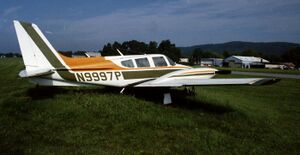Engineering:Piper PA-40 Arapaho
| PA-40 Arapaho | |
|---|---|

| |
| Role | Twin-engined cabin monoplane |
| National origin | United States |
| Manufacturer | Piper |
| First flight | 16 January 1973 |
| Status | Cancelled |
| Number built | Three |
The Piper PA-40 Arapaho was an American twin-engined cabin monoplane designed by Piper as a replacement for the PA-39 Twin Comanche C/R.[1]
Like most Piper products at this time, the PA-40 was named after a Native American tribe, in this case the Arapaho.
Development
The Arapaho was similar in size to the Twin Comanche and had six seats but had a taller main landing gear and larger cabin windows.[1] It had two counter-rotating 160 hp Lycoming IO-320 engines.[1]
The prototype was damaged in June 1972 when the factory at Lock Haven, Pennsylvania, flooded and the prototype, registered N9999P, did not fly until 16 January 1973.[1] It crashed on 21 September 1973 during spin trials.[1] and the aircraft was redesigned with a taller tailfin. The second modified prototype with normally aspirated engines first flew in April 1974 and was followed by a third aircraft with turbocharged engines.[1]
The PA-40 was type certified on 18 July 1974, as an amendment to the Twin Comanche type certificate. The Arapaho was scheduled to be launched as a 1975 model, but the company decided not to market the aircraft and the project was cancelled in December 1974.[1][2] Piper stated that the cancellation was for financial reasons as it did not want to establish a new production line during the 1973–1975 recession.[3]
Following cancellation the two aircraft were used by Piper as company liaison and communication aircraft, one based at Lock Haven, the other at Lakeland, Florida.[4] Later, one aircraft was scrapped by Piper and the third, registered N9997P, is now privately owned in Texas, following use by the Purdue University student maintenance program.[5][6]
References
Notes
- ↑ 1.0 1.1 1.2 1.3 1.4 1.5 1.6 Peperell & Smith 1987, p. 248
- ↑ Federal Aviation Administration (August 2006). "Type certificate data sheet no. A1EA". http://www.airweb.faa.gov/Regulatory_and_Guidance_Library/rgMakeModel.nsf/0/71e99bb08f02af6a86257212006c4fd3!OpenDocument&Highlight=pa-40&Click=852566E20067A2FD.85dedde3028f02e286257439004b6c7d/$Body/0.1B9E. Retrieved 2009-08-24.[yes|permanent dead link|dead link}}]
- ↑ "Piper defers Arapaho". Flight International: 901. 1974-12-26. http://www.flightglobal.com/pdfarchive/view/1974/1974%20-%202103.html.
- ↑ "Lock Haven: Pipe's front line". Flight International: 486. 1978-08-12. http://www.flightglobal.com/pdfarchive/view/1978/1978%20-%201536.html.
- ↑ "Piper PA-40 Arapaho". https://registry.faa.gov/aircraftinquiry/NNum_Results.aspx?NNumbertxt=9998P. Retrieved 2020-05-02.
- ↑ LoRusso, Michael (April 2004). "Piper PA-40 Arapaho". https://www.airliners.net/photo/Untitled/Piper-PA-40-Arapaho/564551?qsp=eJwtjEEKAjEMRe%2BStRsRlM5OD6Cz8AIh%2BejgaEsa0DLM3Y3F3eM9eAtJfjk%2Bfm0FNFAFm9xpQ4WNn5WGhR5o72waTOeU0mGMWrP5qYVRdhxFUBz69xdT2C%2BhSh/dYrwNgI2dabcPr1MtM/cHnKeZ1vULDMcuGw%3D%3D. Retrieved 2009-08-24.
Bibliography
- Peperell, Roger W; Smith, Colin M. (1987). Piper Aircraft and their forerunners. Tonbridge, Kent, England: Air-Britain. ISBN 0-85130-149-5.
External links
 |

